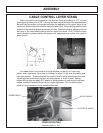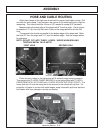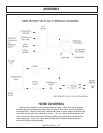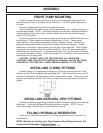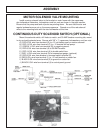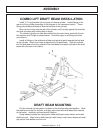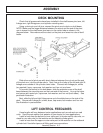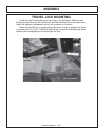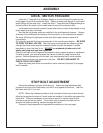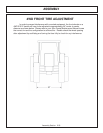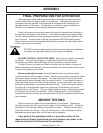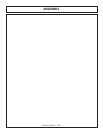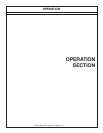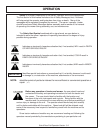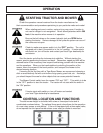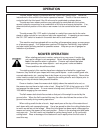
Assembly Section 2-19
ASSEMBLY
DECK / MOTOR FEEDLINE
Install the 1” hose with the 90 degree flange on the front side of the motor to the
inside upper oil port of the solenoid valve. Secure to motor with flange kit, and install
swivel fittings on the other end. Install the other 1” hose with the 60 degree flange on
the back side of the motor to the inside lower oil port of the solenoid valve.
Install split hoses around hydraulic hoses where they contact sharp edges, or any
other edges that may rub hoses.
Be sure that all grease zerks are installed in the draft beam pin bosses. Grease
all areas of the draft beam according to the instructions in the maintenance section.
Re-check all fittings for tightness and be sure teflon tape has been used at all
connections.
Fill hydraulic tank with fluid as recommended in the maintenance section. BE SURE
TO OPEN THE BALL VALVES. Start the tractor and operate the inboard cylinder
through the entire stroke and the outboard cylinder through the bottom ¾ stroke
repeatedly to clear the lines of air. DO NOT run outboard cylinder out to full
stroke until stop bolt has been adjusted!
Check for oil leaks at all fittings and connections using a piece of paper or cardboard.
If a leak is found, you must shut down the tractor and set the cutter head on the
ground. Before attempting to fix the leak, you must actuate the lift valve handles
several times to relieve any pressure in the lines. DO NOT USE HANDS TO
CHECK FOR FLUID LEAKS!
Raise the three point hitch and check the tractor internal hydraulics, fill to proper
level if needed.
STOP BOLT ADJUSTMENT
Extend the outboard cylinder all the way out. Adjust the stop adjustment bolt
(located on the top of the draft beam) out until it is up against the bonnet. Lock the
bolt down with the ¾” hex nut.
NOTE: When the outboard cylinder is fully extended, the bonnet or deck should
either be up against the stop or if travel locks are installed, it should be up against the
travel lock. It may be necessary to use either external or internal slugs on the
cylinder to get the correct stroke. If the cutter head is against the stop and the
cylinder has stoke remaining, serious damage will occur.
Proceed to final preparation for operation instructions on the next page.



